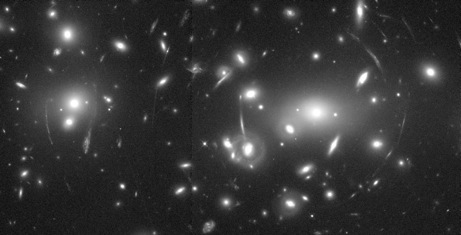Physical Cosmology Group
Abell 2218 (Credit: NASA Images)

We are located at the University Observatory Munich (USM). We work on the interface between theoretical and observational cosmology. Our main research interest is in confronting modern cosmological theories with observations. Here we have in particular a strong research program in exploiting galaxy clusters and cosmic voids, but also in more general probes of the large-scale structure and the cosmic microwave back ground. One of our main motivations is to understand the nature of the cosmic acceleration in the Universe. Here we try to constrain theoretical models from standard dark energy, coupled scalar fields to theories which extend Einstein's gravity at large distances. In order to achieve this goal we use analytical and numerical methods, such as N-body simulations of the structure formation process, state of the art statistical analysis tools and modern Bayesian techniques. Furthermore we have a strong research program in machine learning applications in astrophysics, but also apply these methods in medical physics and string theory.
We are involved in the following national and international collaborations: The Dark Energy Survey DES, The Euclid satellite mission of ESA, the Dark Energy Science Collaboration DESC at the Rubin Observatory Legacy Survey of Space and Time, the Hobby-Eberly Telescope Dark Energy Experiment HETDEX, the eRosita x-ray satellite mission, the Square Kilometer Array SKA and the LiteBird satellite mission.
We work together with other groups at the Max Planck institutes. Among others: OPINAS and High Energy Astrophysics groups at MPE, the Cosmology research group at MPA, as well as with members of other groups at the Excellence Cluster and groups at MPP.
|
Recent Papers by Group Members Euclid preparation. Measuring detailed galaxy morphologies for Euclid with Machine Learning, Euclid Collaboration et al.,arXiv:2402.10187 Euclid preparation. Optical emission-line predictions of intermediate-z galaxy populations in GAEA for the Euclid Deep and Wide Surveys, Euclid Collaboration et al.,2024arXiv240203436E The SRG/eROSITA all-sky survey. First X-ray catalogues and data release of the western Galactic hemisphere, Merloni, A. et al.,Astronomy and Astrophysics, 682, A34, (2024) The perspective of voids on rising cosmology tensions, Contarini, S. et al.,Astronomy and Astrophysics, 682, A20, (2024) On the relative bias of void tracers in the Dark Energy Survey, Pollina, G. et al.,Monthly Notices of the Royal Astronomical Society, 487, 2836, (2019) The Dark Energy Survey Image Processing Pipeline, Morganson, E. et al.,Publications of the Astronomical Society of the Pacific, 130, 074501, (2018) Searching for time-dependent axion dark matter signals in pulsars, Battye, R. A. et al.,Physical Review D, 108, 063001, (2023) `pgmuvi`: Quick and easy Gaussian Process Regression for multi-wavelength astronomical timeseries, Scicluna, P. et al.,arXiv:2308.00132 Increased accuracy of the two-point correlation function at no extra cost, Kerscher, Martin et al.,10.48550/arXiv.2401.05942 Improving the accuracy of estimators for the two-point correlation function, Kerscher, Martin et al.,Astronomy and Astrophysics, 666, A181, (2022) Synergy between cosmological and laboratory searches in neutrino physics, Gerbino, Martina et al.,Physics of the Dark Universe, 42, 101333, (2023) Cosmological covariance of fast radio burst dispersions, Reischke, Robert et al.,Monthly Notices of the Royal Astronomical Society, 524, 2237, (2023) Why Cosmic Voids Matter: Mitigation of Baryonic Physics, Schuster, Nico et al.,2023arXiv231211241S |

